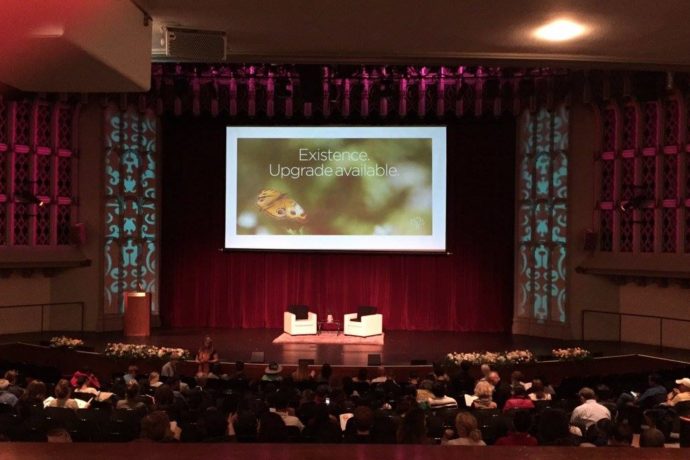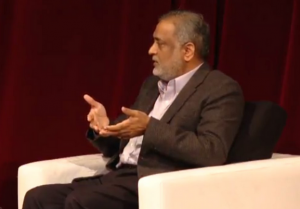As I leaned back in my chair and tried to focus on my breathing for the umpteenth time, a loud snore ripped through the auditorium, jolting me out of my seconds-long quest for healing and transformation.
An attendee several rows back continued to enjoy his nap until Dr. Kamlesh D. Patel, the keynote speaker at the University of Southern California’s Heartfulness conference ended the exercise.
“I like to move beyond spirituality because this journey is infinite. It’s about moving from knowledge to feelings to perception. Meditation helps us do that. You are the scientist and your heart is the laboratory,” said an avuncular Patel to moderator Varun Soni, the dean of religious life at USC.
As he spoke, a slideshow projected in the background featuring idyllic scenes of butterflies and double rainbows with flashes of phrases such as, “Why not magnificence?” and, “Peace, love and neuroplasticity.”
Patel describes “heartfulness” as a technique for finding inner harmony by connecting to the heart. Though the Heartfulness institute claims not to be affiliated with any religion, Patel, its founder, is also the director and principal teacher of a spiritual school known as Sahaj Marg, or “the natural path.” His role is described on the organization’s site as “current living spiritual Master” of a tradition that dates, according to a brief history, to the late 19th century in India.
Capitalizing on the moment “mindfulness” is having, “heartfulness” seems designed to fit easily onto the menu of Western spiritual aspiration.
Moreover, a post from the Heartfulness Facebook page seems to base heartfulness’ worth in its potential value to capitalism, boasting statistics of increased productivity and decreased absenteeism when workers at a Detroit firm adopted meditation. Odd that a practice said to be rooted in simplicity would attach itself to profit-centered thinking, but maybe that’s how heartfulness must be rebranded to appeal to Americans.
As someone who grew up attending dour Catholic masses with stony-faced liturgies, the idea of a magically upgraded life due to the power of positive thoughts and inner calm gets me kind of frowny. It’s the same cynicism that makes me hate The Secret and politely ignore “law of attraction” videos from friends that pepper my inbox. Despite this, I was determined to approach the conference with an open mind (or open heart as they’d rather have me say).
However, both Soni and Patel seemed curiously vague when discussing the most intriguing—and some might say eyebrow-raising—aspect of heartfulness, namely something called “yogic transmission,” or the “utilization of divine energy for the transformation of man.”
Aspirants are invited to try the simple techniques of heartfulness on their own, and then to sign up for heartfulness-plus-transmission. It can be accomplished remotely, or in person, the site explains.
Patel said he didn’t want to “get too into it” here.
Even a visit to Heartfulness’ website and social media pages doesn’t offer much more in the way of an explanation, only the guarantee that yogic transmission is “the essence of a good inner life that must be experienced to be appreciated.”
USC, a world-renowned research university, seems to be an odd choice for the Heartfulness organization to make its West Coast landfall.
But as Varun Soni reminded the audience, citing recent Pew statistics, young people are increasingly looking outside of organized religion for spiritual meaning.
And it appears the on-campus conference dedicated to the Heartfulness brand of meditation is only the start. The organization will now hold weekly meditation sessions in the University Religious Center every Sunday morning, a yoga mat replacing the pews some attendees might have been used to.
The diverse crowd of young people seemed to be there for a variety of reasons. Kacie Amacher, a medical school student, was there to find out more about the health applications of heartfulness. “I wasn’t sure what to expect, but it was really great. I figured I should learn about this an alternative medicine technique for future patients.”
Recent USC graduate Ade Mos already meditates but was looking for a new practice. “It really did stir up a lot of new perspectives on the art of living. I was searching for insights that were profound and novel.”
As anyone who’s spent considerable time in Los Angeles could attest to, there’s a palpable sense of “searching” here. The young and the unaffiliated—transplants and natives alike—are unmoored and perpetually sniffing out the next big thing that will give them fulfillment. Heck, the Heartfulness organization even received an official mayoral welcoming from Los Angeles Mayor Eric Garcetti.
Despite its self-described foundation in ancient cultures, Heartfulness-the-brand seems very much a 21st-century operation. There’s a toll-free number for people to call where if you press three, you’ll be connected to a Heartfulness associate in North America. The organization offers a livestream of conferences on their web site, and there are heartfulness apps with virtual instructors on iTunes and Google Play.
The one thing the conference seemed to tout above all else was accessibility.
“This does not exert you economically. Because there are no fees here. Peace cannot be purchased. Harmony cannot be purchased. Love cannot be purchased,” Patel told the packed auditorium.
Indeed, the Heartfulness organization embraces that idea that enlightenment shouldn’t cost a penny—at least not at first. The conference and the materials were free, and there’s nary a dollar sign to be seen for any of their heartfulness services on the website. But for the organization to have the reach and global real estate it apparently possesses, there is certainly a point at which revenue (donation!) is extracted. That combined with the nebulous promise of transformation (if only you connect with a Los Angeles-based trainer!) earned a side-eye or five from me.
Is it possible that Heartfulness’ newest adherents will go beyond the glossy wellness regime the organization promotes and question its inner workings? Don’t hold your breath.






